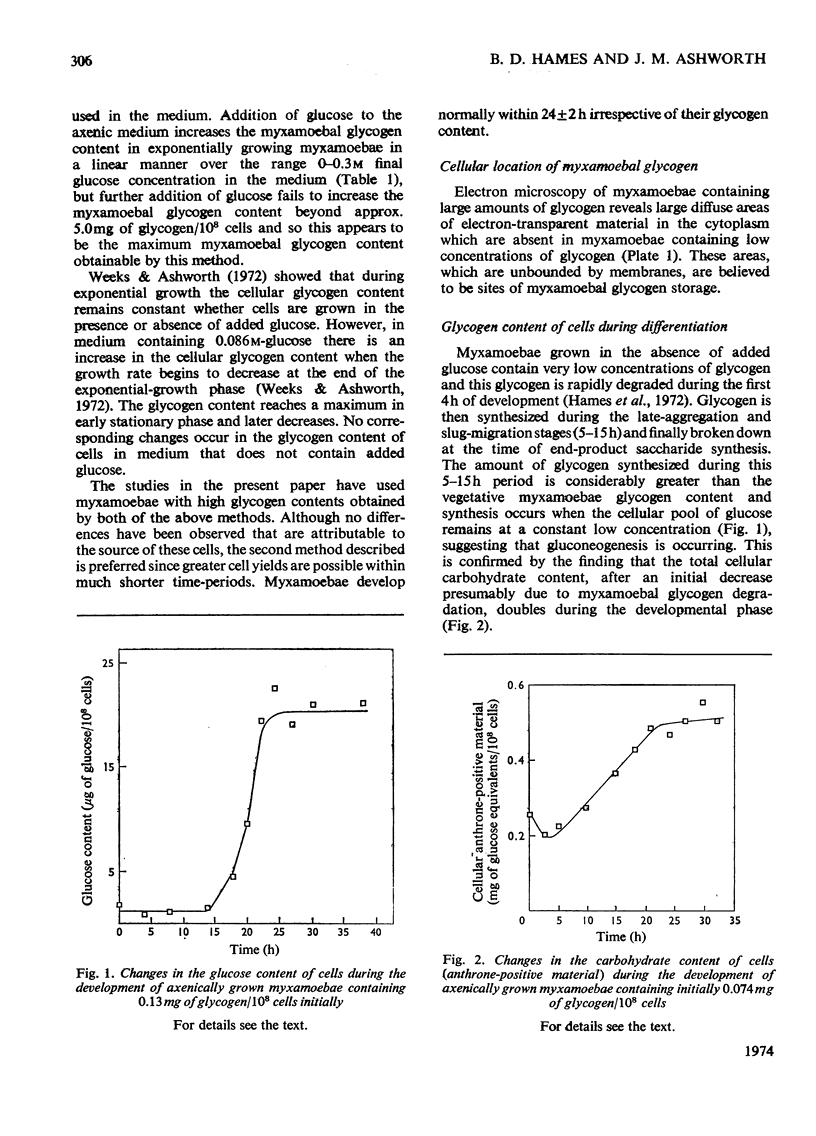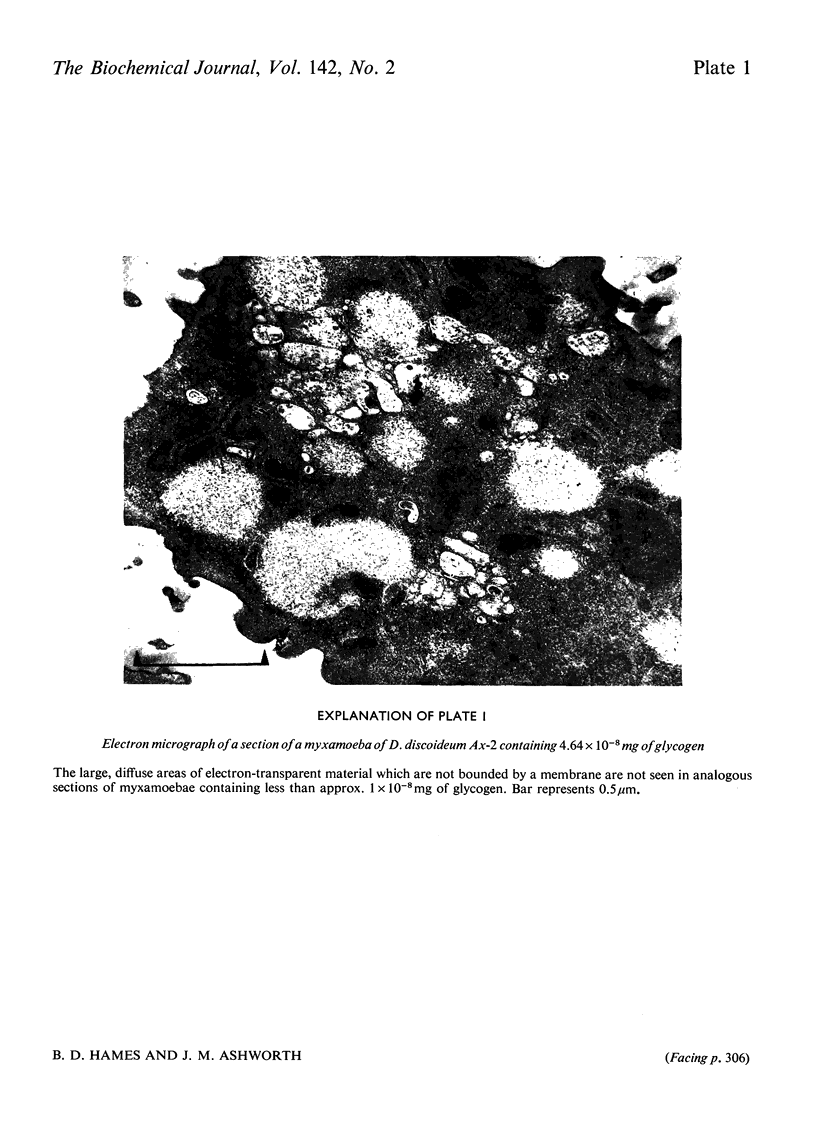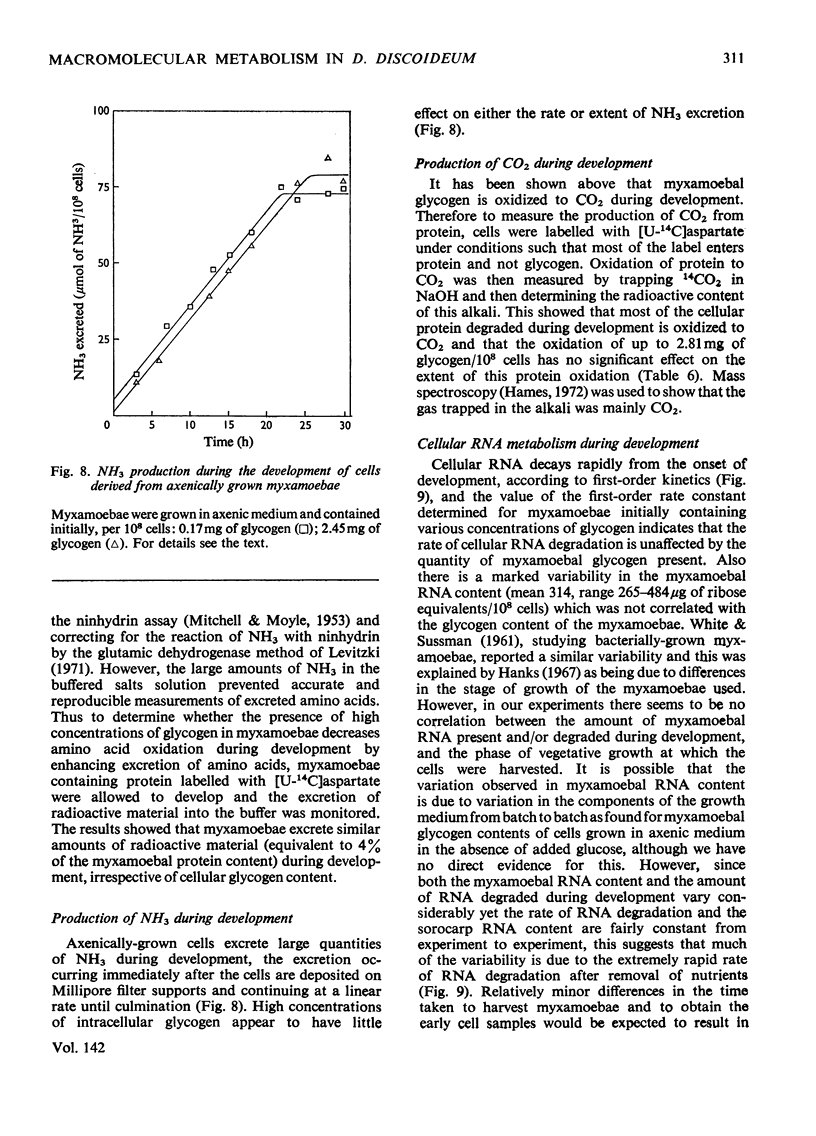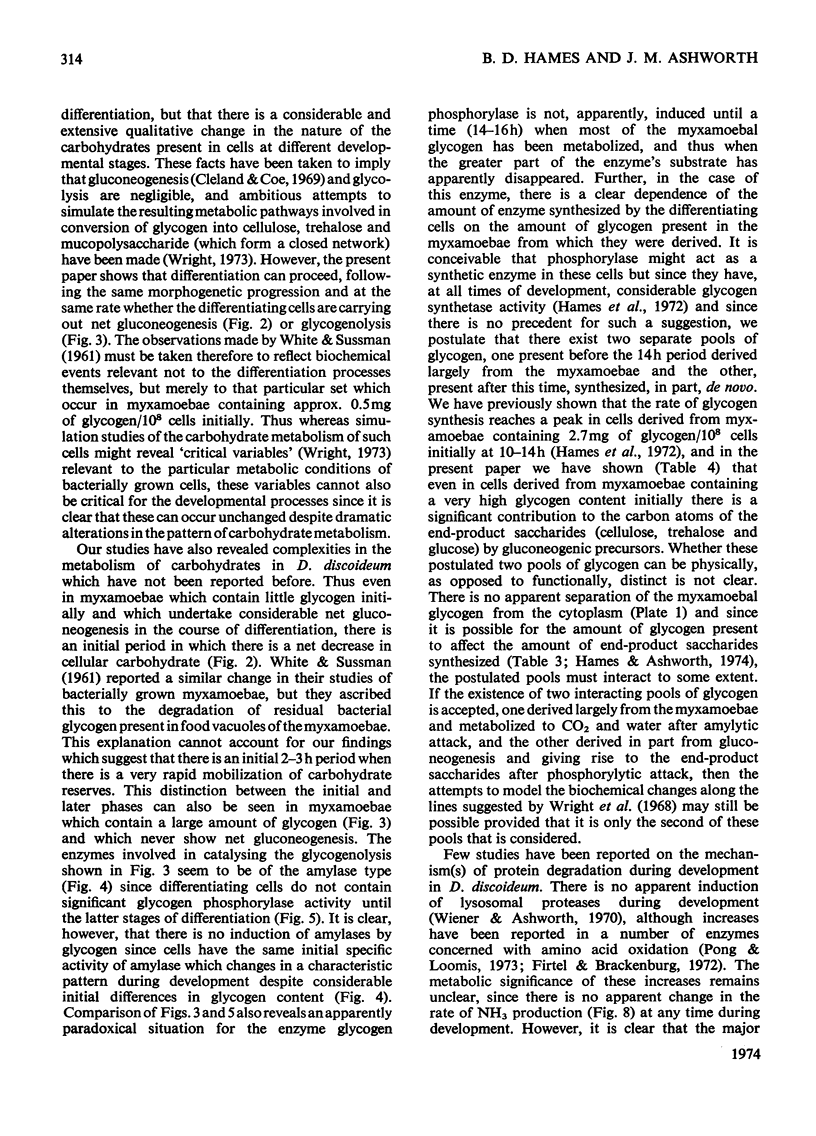Abstract
1. Methods of obtaining myxamoebae of Dictyostelium discoideum strain Ax-2 (ATCC 24397) with glycogen contents in the range 0.05–5mg of glycogen/108 cells are described. The changes in cellular glycogen, protein and RNA content during the differentiation of such myxamoebae were determined. 2. Myxamoebal glycogen is not conserved during differentiation and gluconeogenesis may occur even in cells that contain a large amount of glycogen initially. 3. There is a marked net loss of cellular protein and RNA during differentiation and associated with this there are also marked decreases in the sizes of the intracellular pools of amino acids, acid-soluble proteins and pentose-containing materials. 4. During the early stages of development some protein and pentose(s) are excreted, but this cannot account for the decreased cellular content of protein and RNA. 5. There is a linear rate of production of NH3 during development, and oxidation appears to be the fate of the major portion of the degraded protein and RNA. 6. However, provision of an alternative metabolizable energy source (glycogen) has little effect on the rate or extent of protein or RNA breakdown or on the changes in the sizes of the intracellular pools of amino acids, acid-soluble proteins and pentose-containing materials. 7. It is concluded that during development there is a requirement for the destruction of specific RNA and protein molecules for reasons other than the provision of oxidizable substrates. 8. The kinetic model of Wright et al. (1968) is discussed in relation to these changes in macromolecular content.
Full text
PDF















Images in this article
Selected References
These references are in PubMed. This may not be the complete list of references from this article.
- Ashworth J. M., Quance J. Enzyme synthesis in myxamoebae of the cellular slime mould Dictyostelium discoideum during growth in axenic culture. Biochem J. 1972 Feb;126(3):601–608. doi: 10.1042/bj1260601. [DOI] [PMC free article] [PubMed] [Google Scholar]
- Ashworth J. M., Watts D. J. Metabolism of the cellular slime mould Dictyostelium discoideum grown in axenic culture. Biochem J. 1970 Sep;119(2):175–182. doi: 10.1042/bj1190175. [DOI] [PMC free article] [PubMed] [Google Scholar]
- BAILLIE L. A. Determination of liquid scintillation counting efficiency by pulse-height shift. Adv Tracer Methodol. 1963;1:86–92. doi: 10.1007/978-1-4684-8619-3_17. [DOI] [PubMed] [Google Scholar]
- BRONSWEIG R. D., GREGG J. H. Biochemical events accompanying stalk formation in the slime mold, Dictyostelium discoideum. J Cell Physiol. 1956 Oct;48(2):293–299. doi: 10.1002/jcp.1030480210. [DOI] [PubMed] [Google Scholar]
- Cleland S. V., Coe E. L. Conversion of aspartic acid to glucose during culmination of Dictyostelium discoideum. Biochim Biophys Acta. 1969 Dec 30;192(3):446–454. doi: 10.1016/0304-4165(69)90393-6. [DOI] [PubMed] [Google Scholar]
- Cooper R. A., Kornberg H. L. The direct synthesis of phosphoenolpyruvate from pyruvate by Escherichia coli. Proc R Soc Lond B Biol Sci. 1967 Sep 12;168(1012):263–280. doi: 10.1098/rspb.1967.0065. [DOI] [PubMed] [Google Scholar]
- England P. J., Randle P. J. Effectors of rat-heart hexokinases and the control of rates of glucose phosphorylation in the perfused rat heart. Biochem J. 1967 Dec;105(3):907–920. doi: 10.1042/bj1050907. [DOI] [PMC free article] [PubMed] [Google Scholar]
- Firtel R. A., Bonner J. Developmental control of -1-4 glucan phosphorylase in the cellular slime mold Dictyostelium discoideum. Dev Biol. 1972 Sep;29(1):85–103. doi: 10.1016/0012-1606(72)90046-2. [DOI] [PubMed] [Google Scholar]
- Firtel R. A., Brackenbruy R. W. Partial characterization of several protein and amino acid metabolizing enzymes in the cellular slime mold Dictyostelium discoideum. Dev Biol. 1972 Mar;27(3):307–321. doi: 10.1016/0012-1606(72)90170-4. [DOI] [PubMed] [Google Scholar]
- Garrod D. R., Ashworth I. M. Effect of growth conditions on development of the cellular slime mould, Dictyostelium discoideum. J Embryol Exp Morphol. 1972 Oct;28(2):463–479. [PubMed] [Google Scholar]
- HARLAN J. W. Liquid scintillaton counting of C-14-O2 in aqueous carbonate solutions. Adv Tracer Methodol. 1963;1:115–118. [PubMed] [Google Scholar]
- HILL E. P., SUSSMAN A. S. PURIFICATION AND PROPERTIES OF TREHALASE (S) FROM NEUROSPORA. Arch Biochem Biophys. 1963 Sep;102:389–396. doi: 10.1016/0003-9861(63)90246-7. [DOI] [PubMed] [Google Scholar]
- Hames B. D., Ashworth J. M. The control of saccharide synthesis during development of Myxamoebae of Dictyostelium discoideum containing differing amounts of glycogen. Biochem J. 1974 Aug;142(2):317–325. doi: 10.1042/bj1420317. [DOI] [PMC free article] [PubMed] [Google Scholar]
- Hames B. D., Weeks G., Ashworth J. M. Glycogen synthetase and the control of glycogen synthesis in the cellular slime mould Dictyostelium discoideum during cell differentiation. Biochem J. 1972 Feb;126(3):627–633. doi: 10.1042/bj1260627. [DOI] [PMC free article] [PubMed] [Google Scholar]
- Jones T. H., Wright B. E. Partial purification and characterization of glycogen phosphorylase from Dictyostelium discoideum. J Bacteriol. 1970 Nov;104(2):754–761. doi: 10.1128/jb.104.2.754-761.1970. [DOI] [PMC free article] [PubMed] [Google Scholar]
- LOWRY O. H., ROSEBROUGH N. J., FARR A. L., RANDALL R. J. Protein measurement with the Folin phenol reagent. J Biol Chem. 1951 Nov;193(1):265–275. [PubMed] [Google Scholar]
- Levitzki A. Determination of submicro quantities of ammonia. Anal Biochem. 1970 Feb;33(2):335–340. doi: 10.1016/0003-2697(70)90304-0. [DOI] [PubMed] [Google Scholar]
- MASTER R. W. POSSIBLE SYNTHESIS OF POLYRIBONUCLEOTIDES OF KNOWN BASE-TRIPLET SEQUENCES. Nature. 1965 Apr 3;206:93–93. doi: 10.1038/206093b0. [DOI] [PubMed] [Google Scholar]
- MITCHELL P., MOYLE J. M. Paths of phosphate transfer in Micrococcus pyogenes: phosphate turnover in nucleic acids and other fractions. J Gen Microbiol. 1953 Oct;9(2):257–272. doi: 10.1099/00221287-9-2-257. [DOI] [PubMed] [Google Scholar]
- Pong S. S., Loomis W. F., Jr Replacement of an anabolic threonine deaminase by a catabolic threonine deaminase during development of Dictyostelium discoideum. J Biol Chem. 1973 Jul 25;248(14):4867–4873. [PubMed] [Google Scholar]
- Quance J., Ashworth J. M. Enzyme synthesis in the cellular slime mould Dictyostelium discoideum during the differentiation of myxamoebae grown axenically. Biochem J. 1972 Feb;126(3):609–615. doi: 10.1042/bj1260609. [DOI] [PMC free article] [PubMed] [Google Scholar]
- TREVELYAN W. E., PROCTER D. P., HARRISON J. S. Detection of sugars on paper chromatograms. Nature. 1950 Sep 9;166(4219):444–445. doi: 10.1038/166444b0. [DOI] [PubMed] [Google Scholar]
- WHITE G. J., SUSSMAN M. Metabolism of major cell components during slime mold morphogenesis. Biochim Biophys Acta. 1961 Oct 28;53:285–293. doi: 10.1016/0006-3002(61)90441-3. [DOI] [PubMed] [Google Scholar]
- WRIGHT B. E., ANDERSON M. L. Protein and amino acid turnover during differentiation in the slime mold. I. Utilization of endogenous amino acids and proteins. Biochim Biophys Acta. 1960 Sep 9;43:62–66. doi: 10.1016/0006-3002(60)90407-8. [DOI] [PubMed] [Google Scholar]
- Watts D. J., Ashworth J. M. Growth of myxameobae of the cellular slime mould Dictyostelium discoideum in axenic culture. Biochem J. 1970 Sep;119(2):171–174. doi: 10.1042/bj1190171. [DOI] [PMC free article] [PubMed] [Google Scholar]
- Weeks G., Ashworth J. M. Glycogen synthetase and the control of glycogen synthesis in the cellular slime mould Dictyostelium discoideum during the growth (myxamoebal) phase. Biochem J. 1972 Feb;126(3):617–626. doi: 10.1042/bj1260617. [DOI] [PMC free article] [PubMed] [Google Scholar]
- Wiener E., Ashworth J. M. The isolation and characterization of lysosomal particles from myxamoebae of the cellular slime mould Dictyostelium discoideum. Biochem J. 1970 Jul;118(3):505–512. doi: 10.1042/bj1180505. [DOI] [PMC free article] [PubMed] [Google Scholar]
- Wright B., Simon W., Walsh B. T. A kinetic model of metabolism essential to differentiation in Dictyostelium discoideum. Proc Natl Acad Sci U S A. 1968 Jun;60(2):644–651. doi: 10.1073/pnas.60.2.644. [DOI] [PMC free article] [PubMed] [Google Scholar]



